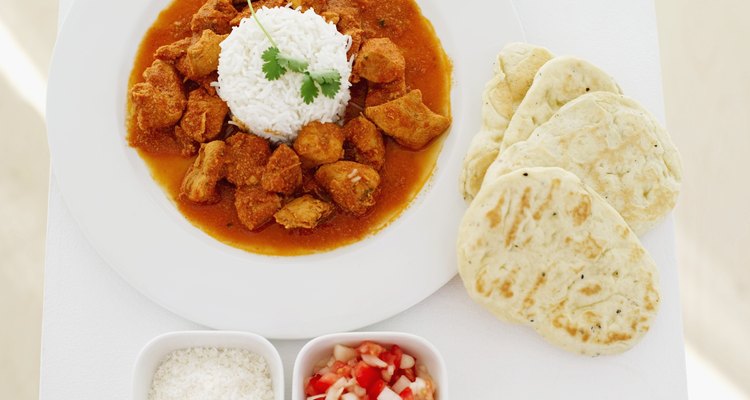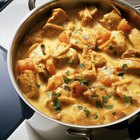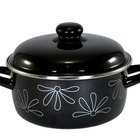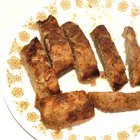
Chapati and Tandoori roti are both common breads made in India. Chapati, also known as roti, or fulka, depending on the area of India, are cooked at home nearly every day and are a staple food for the majority of Indians. Tandoori rotis require a special type of oven, called a tandoor, predominantly found at restaurants. It is not common for a housewife to have a tandoor. Both are made of flour, but chapati is made of whole wheat flour, while tandoor roti is made of maida, or white all-purpose flour. Both breads pair with any Indian food.
Cooking Process
Chapatis are fried in a special pan called a tawa. Tawas are slightly convex pans without sides. Either clarified butter or vegetable oil lubricates the pan for cooking. In many instances, the cook may use no oil or butter at all, simply placing the bread onto a hot tawa. Tandoori rotis are slapped onto the inside of a hot tandoor oven and left to cook until done. No oil or butter is used.
Texture
Chapatis have a more dense texture generally than tandoori rotis. During the cooking process they puff up and develop some charring from contact with the pan. Any moisture from the bread dough cooks into the chapati, leaving it with a more chewy consistency once done. Tandoori rotis have a more airy, light texture from puffing during cooking. All the moisture evaporates out during cooking.
Dough and Flavor
Both chapatis and tandoori rotis consist only of flour and water. The different flours lead to different tastes and textures. The whole wheat flour chapatis have a strong wheat flavor and rough texture. Tandoori rotis have a delicate flavor and airy texture. Chapatis are often served with dishes with higher gravy contents, like lentils. Tandoori rotis pair best with chunkier dishes or ground meat dishes.
Ease of Cooking and Safety Concerns
Once a tandoori roti is slapped to the side of the tandoor, you don't have to touch it again until it's done and time to remove it. A chapati requires flipping, sometimes more than once, and must be watched more closely. There is less risk of injury with frying a chapati on the tawa than there is reaching into a tandoor oven to slap on a roti with your bare hands.
Related Articles

What Is Indian Flat Bread Called?

What Is Indian Flatbread Called?

What Is Vegetable Ghee?

How to Make Quick German Spaetzle
How to Cook Meatloaf in a Silicone Loaf ...

What Is the Difference Between a Bagel ...

Easiest Way to Remove a Stuck Bread ...

Can You Bake Sliders?

How to Bake Bread in the Oven

How to Season Granite Grill Cooking ...

How to Cook Rice in a Rice Cooker

What is a Paella Pan?

How to Make Bread Sticks Out of Pizza ...

What Is the Difference Between a ...

How to Make Stuffed Derma

What Are Some Examples of Unleavened ...

How to Bake Bread in a Clay Pot

How to Cook Tortillas in the Oven

What Are the Causes for an Uncooked ...

How to Bake Breaded Mahi Mahi
References
Writer Bio
Based in southern Virginia, Kristy Robinson has been writing for various websites since 2008. Her work focuses on tutorials and self-help articles. Robinson holds a Bachelor of Science in criminal justice from American InterContinental University.
Photo Credits
Stockbyte/Stockbyte/Getty Images